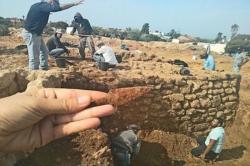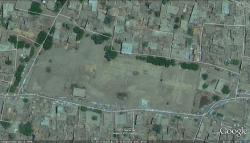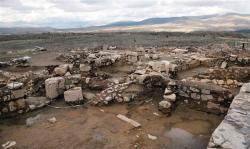INSTITUT SUPERIEUR D'ANTHROPOLOGIE
INSTITUTE OF ANTHROPOLOGY
ONLINE COURSES / COURS A DISTANCE
WINTER TERM : JANUARY 2015
REGISTER NOW
CHINE –  Yanqing - The Beijing Municipal Administration of Cultural Heritage announced that significant mining and metallurgy relics from the Liao Dynasty (907-1125), including a site where ancient miners lived, had recently been discovered in the Yanqing District of Beijing. After three years of surveying and archaeological excavations, archaeologists and researchers were able to find both mines and metallurgical sites, as well as sites in which miners and their families lived and worked. In addition to five mines and four metallurgical sites, 10 ancient furnaces for fining iron were also discovered. Furthermore, specialists also excavated three of the ancient miners' living sites, which spanned an area of 20,000 square meters. A large number of porcelain pieces from the Liao Dynasty, coins from the Northern Song Dynasty and many other cultural relics were found during the excavation. The remaining ancient houses uncovered by archaeologists were in very poor condition. This discovery is extremely significant to Chinese archaeology because it provides evidence that the metallurgical technology of the Liao Dynasty had reached the level of modern industry. In other words, ancient Chinese metallurgical technology was the best in the world at that time.
Yanqing - The Beijing Municipal Administration of Cultural Heritage announced that significant mining and metallurgy relics from the Liao Dynasty (907-1125), including a site where ancient miners lived, had recently been discovered in the Yanqing District of Beijing. After three years of surveying and archaeological excavations, archaeologists and researchers were able to find both mines and metallurgical sites, as well as sites in which miners and their families lived and worked. In addition to five mines and four metallurgical sites, 10 ancient furnaces for fining iron were also discovered. Furthermore, specialists also excavated three of the ancient miners' living sites, which spanned an area of 20,000 square meters. A large number of porcelain pieces from the Liao Dynasty, coins from the Northern Song Dynasty and many other cultural relics were found during the excavation. The remaining ancient houses uncovered by archaeologists were in very poor condition. This discovery is extremely significant to Chinese archaeology because it provides evidence that the metallurgical technology of the Liao Dynasty had reached the level of modern industry. In other words, ancient Chinese metallurgical technology was the best in the world at that time.
http://beijing.china.org.cn/2014-11/26/content_34156709.htm
INDE –  Sambalpur - The State Archaeology wing has detected 70 cracks in the structures surrounding the Samaleswari temple here. As the archaeologists stated that the cracks were very old, the locals have questioned the efficacy of the temple trust boards. Cracks have been found in the structures housing the Parswa Devatas, the corridor around the temple and four domes of the main temple. However, the cracks in the main temple have not been ascertained. The 16th century shrine, which was constructed by Balram Dev, the first Chauhan king of Sambalpur and the founder of modern Sambalpur, is a major tourist spot in Western Odisha. The temple was constructed in proto-Nagara style. The Samaleswari temple attracts thousands of devotees from across Odisha and neighbouring States of Chhattisgarh and Jharkhand every year.
Sambalpur - The State Archaeology wing has detected 70 cracks in the structures surrounding the Samaleswari temple here. As the archaeologists stated that the cracks were very old, the locals have questioned the efficacy of the temple trust boards. Cracks have been found in the structures housing the Parswa Devatas, the corridor around the temple and four domes of the main temple. However, the cracks in the main temple have not been ascertained. The 16th century shrine, which was constructed by Balram Dev, the first Chauhan king of Sambalpur and the founder of modern Sambalpur, is a major tourist spot in Western Odisha. The temple was constructed in proto-Nagara style. The Samaleswari temple attracts thousands of devotees from across Odisha and neighbouring States of Chhattisgarh and Jharkhand every year.
http://www.newindianexpress.com/states/odisha/2014/11/26/Cracks-Appear-in-Samaleswari-Temple/article2541368.ece
PALESTINE –  Netiv Haasarah - Archaeological excavations in Netiv Haasarah have uncovered a Persian era military installation that dates to the era of the Second Temple. Netiv Haasarah is a town in the “Gaza envelope” with a population of about 700. The dig, being headed by Dr. Yael Abadi Rice, found a fortified town and a military tower, from approximately 2,100 years ago. This time period was when the Second Temple was standing in Jerusalem. “It seems this was a military outpost”, Dr. Rice told Tazpit News Agency. “Besides for the army stationed there, people were sent there to work the area on the road from Ashkelon to Gaza.” The outpost had the military tower as well as residential buildings and warehouses. The tower, built of limestone and mud bricks, was found with a partially preserved staircase. Inside the warehouses, archeologists were surprised to find intact pottery and stone utensils, as well as oil and wine jars. “The site shows the military being pushed back. It seems they ran away in a hurry, as they left everything behind,” Dr. Rice explained. “It may have been Alexander the Great, and it may have been a little earlier. We are working to understand who it was that attacked the outpost.” Both the town and the tower were destroyed in a violent fashion. A layer of ash shows they were burnt. The dig is being done to prepare a parcel of land for a new neighborhood in the town. It was particularly hard hit by rocket fire during Operation Protective Edge. “It is truly nice to see that despite the wars here, people keep coming back here to rebuild, and to live,” said Dr. Rice.
Netiv Haasarah - Archaeological excavations in Netiv Haasarah have uncovered a Persian era military installation that dates to the era of the Second Temple. Netiv Haasarah is a town in the “Gaza envelope” with a population of about 700. The dig, being headed by Dr. Yael Abadi Rice, found a fortified town and a military tower, from approximately 2,100 years ago. This time period was when the Second Temple was standing in Jerusalem. “It seems this was a military outpost”, Dr. Rice told Tazpit News Agency. “Besides for the army stationed there, people were sent there to work the area on the road from Ashkelon to Gaza.” The outpost had the military tower as well as residential buildings and warehouses. The tower, built of limestone and mud bricks, was found with a partially preserved staircase. Inside the warehouses, archeologists were surprised to find intact pottery and stone utensils, as well as oil and wine jars. “The site shows the military being pushed back. It seems they ran away in a hurry, as they left everything behind,” Dr. Rice explained. “It may have been Alexander the Great, and it may have been a little earlier. We are working to understand who it was that attacked the outpost.” Both the town and the tower were destroyed in a violent fashion. A layer of ash shows they were burnt. The dig is being done to prepare a parcel of land for a new neighborhood in the town. It was particularly hard hit by rocket fire during Operation Protective Edge. “It is truly nice to see that despite the wars here, people keep coming back here to rebuild, and to live,” said Dr. Rice.
http://www.jspacenews.com/second-temple-era-military-outpost-found-possibly-destroyed-alexander-great/
EGYPTE –  Erment - The Egyptian Ministry of Antiquities announced on Sunday that the head of the statue of King Thutmosis III, one of the main founders of the “The Age of the Empire” (1567 BC - 1085 BC) was discovered in southern Egypt. Minister of Antiquities Mamdouh Al-Damaty said in a statement that the mission of the French Archaeological Institute, in collaboration with the Ministry of Antiquities, discovered the head of the statue in the Temple of Armant west of Luxor, also called the Temple of Montu the god of war. It dates back to the era of Tuthmosis III and Queen Hatshepsut, and was rebuilt in the Ptolemaic period. The French mission had last year also discovered in the temple five heads of statues and a statue of a priest.Archaeologist Abdel Halim Nour Eddin said that discovering the head of the statue in this place proves that God Montu was strongly linked to Thebes just like God Amun. He added that the statues of Tuthmosis are smaller than those of Amenhotep III and Ramses II because he was busy fighting wars. “He was the greatest military figure in the history of Egypt and the first to develop a right and left regiment for the army,” he explained. “His military campaigns were accompanied by scientific missions to document foreign countries.”
Erment - The Egyptian Ministry of Antiquities announced on Sunday that the head of the statue of King Thutmosis III, one of the main founders of the “The Age of the Empire” (1567 BC - 1085 BC) was discovered in southern Egypt. Minister of Antiquities Mamdouh Al-Damaty said in a statement that the mission of the French Archaeological Institute, in collaboration with the Ministry of Antiquities, discovered the head of the statue in the Temple of Armant west of Luxor, also called the Temple of Montu the god of war. It dates back to the era of Tuthmosis III and Queen Hatshepsut, and was rebuilt in the Ptolemaic period. The French mission had last year also discovered in the temple five heads of statues and a statue of a priest.Archaeologist Abdel Halim Nour Eddin said that discovering the head of the statue in this place proves that God Montu was strongly linked to Thebes just like God Amun. He added that the statues of Tuthmosis are smaller than those of Amenhotep III and Ramses II because he was busy fighting wars. “He was the greatest military figure in the history of Egypt and the first to develop a right and left regiment for the army,” he explained. “His military campaigns were accompanied by scientific missions to document foreign countries.”
http://www.egyptindependent.com//news/french-mission-discovers-head-king-thutmosis-iii-statue
TURQUIE –  Pisidia- A Roman-era house that has been unearthed in the ancient city of Pisidia in the southern province of Isparta’s Yalvaç district used the floor heating system, archaeologists have said, adding that the house also had water and sewage systems. “We determined that it is a two-story house, with a bath, sauna and floor-heating system. The whole floor of the house was heated up with the furnace. We also unearthed a water system in the house,” said Süleyman Demirel University Archaeology Department Professor Mehmet Özhanlı, who is heading the excavations in Pisidia, an important center of early Christianity. The house, which was discovered last year and covers an area of nearly 2,000 square meters, was built in 25 B.C. and resembled a typical Anatolian house. The professor said the house had been used until the 11th century, adding that it was located on the avenue, which means that it was owned by a rich or notable Roman. “We don’t have more concrete data about it, but we know the building was home to many different civilizations until the 11th century,” he said. Özhanlı said traces showed that the house had been burned down. “Below the layer of fire we found Christian iconographic paintings on marble. It shows that the house was mostly used in the fourth century. Most probably, it was burned down during Arab raids in the eighth century,” he said. Excavations have been continuing at Pisidia for the past five years.
Pisidia- A Roman-era house that has been unearthed in the ancient city of Pisidia in the southern province of Isparta’s Yalvaç district used the floor heating system, archaeologists have said, adding that the house also had water and sewage systems. “We determined that it is a two-story house, with a bath, sauna and floor-heating system. The whole floor of the house was heated up with the furnace. We also unearthed a water system in the house,” said Süleyman Demirel University Archaeology Department Professor Mehmet Özhanlı, who is heading the excavations in Pisidia, an important center of early Christianity. The house, which was discovered last year and covers an area of nearly 2,000 square meters, was built in 25 B.C. and resembled a typical Anatolian house. The professor said the house had been used until the 11th century, adding that it was located on the avenue, which means that it was owned by a rich or notable Roman. “We don’t have more concrete data about it, but we know the building was home to many different civilizations until the 11th century,” he said. Özhanlı said traces showed that the house had been burned down. “Below the layer of fire we found Christian iconographic paintings on marble. It shows that the house was mostly used in the fourth century. Most probably, it was burned down during Arab raids in the eighth century,” he said. Excavations have been continuing at Pisidia for the past five years.
http://www.hurriyetdailynews.com/ancient-house-with-floor-heating-unearthed-in-southern-turkey.aspx?pageID=238&nid=74800&NewsCatID=375